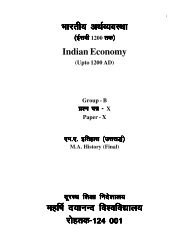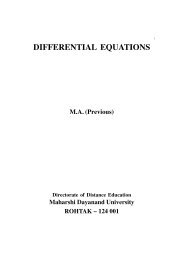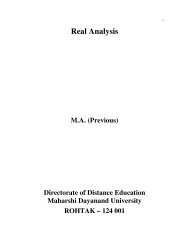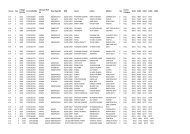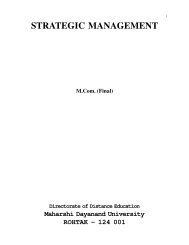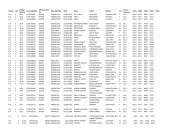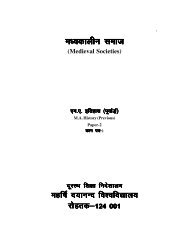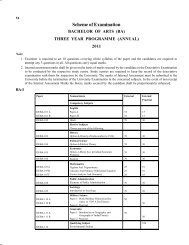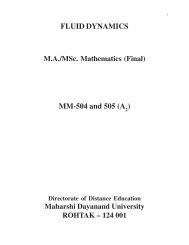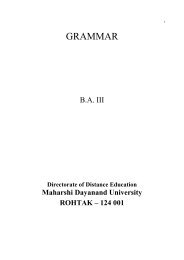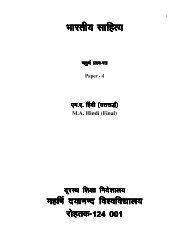LITERATURE AND GENDER - Maharshi Dayanand University, Rohtak
LITERATURE AND GENDER - Maharshi Dayanand University, Rohtak
LITERATURE AND GENDER - Maharshi Dayanand University, Rohtak
You also want an ePaper? Increase the reach of your titles
YUMPU automatically turns print PDFs into web optimized ePapers that Google loves.
Girish Karnad – Nagamandal37at the age of twenty-two, he realized that he could not be a poet, but only a playwright. Until he wrote this play,Karnad fancied himself a poet. During his teens, he had written poetry and had trained himself to write in English.“The greatest ambition of my life was to be a poet,” says Karnad. By the time he was in college, he wanted to writein English, become a novelist and be internationally famous. There have been more poets and more novelists, butthere have been very few playwrights and very few good plays. Karnad further realized that the art of a poet or anovelist was easier than that of a dramatist. As he says:The subject that interests most writers is, of course, themselves and it is easy subject to talk about.But you know it is always easier if you are a poet or a novelist because you are used to talking inyour voice. You suspend your whole life talking as writer directly to the audience. The problem inbeing a playwright is that everything that you write is for someone else to say.A playwright has many problems. What is upsetting for a playwright is the total lack of plays in India, although thecompany Natak tradition made a major contribution that flourished since the early decades of the eighteenth century.Where does the playwright look for the sources? And why does one write plays at all? --questions Karnad. There ishardly any theatre in the country. Karnad got into films in an effort to find some kind of a living audience. Andperhaps to earn his livelihood.Karnad has always found it difficult to find a suitable, rich subject for writing plays. For instance, after writing Yayati,he read all kinds of books in an effort to find a plot, some plot that would truly inspire. He read the history of Kannadaliterature by Kirtinath Kurtkoti and learnt from him that Indian history has not been handled by any Indian writer theway it has been done by Shakespear or Brecht. Greatly impressed by this statement, Karnad went through a book ofIndian history. And when he came to Tughlaq, he said, “Oh! Marvellous. That is what I wanted.” That was a subject intune with the times. In those days, existentialism was quite in fashion. Everything about Tughlaq seemed to fit into whatKarnad had surmised frorn Kurtkoti. He felt that in Tughlaq he had hit upon a fantastic character. He realized tha he hadabsorbed this character and it was growing in front of him. Tughlaq was the most extraordinary character to come to thethrrone of Delhi: in religion, in philosophy, even in calligraphy, in balltle, warfield, and all other areas, he was unsurpassable,no other ruler could match his capability. Writing on such a subject seemed challenging and rewarding.Karnad’s Tughlaq bears several resemblances with Shakespeare’s Richard II. Like King Richard, Muhammad-bin-Tughlaq is temperamental and whimsical. Events in both the plays centre around the eccentricities of their protagonists.Again, like Shakespeare, Karnad presents the historical events and complexities of the time with perfect objectivityof a true historian, throwing upon them the beautiful colouring of art. He exhibits without concealment the weaknessof the king’s character but spares no pain to evoke our whole-hearted pity for him in his fall.Tughlaq had a tremendous success with the reading public and it achieved greater popularity on the stage as actorshave liked to do the role of the emperor. As opposed to the first play, Karnad wrote this one in the convention of theCompany Natakas. For form of the play, Karnad was no more interested in John Anouilh. He divided the play intoscenes in the indigenous fashion of the natakas.The political chaos which Karnad depicts in Tughlaq reminded many readers of the Nehru era in Indian history.Karnad finds this similarity accidental. Says he, “I did not consciously write about the Nehru era. I am alwaysflattered when people tell me that it was about the Nehru era and equally applies to development of politics sincethen, But, I think, well, that is a compliment that any playwright would be thrilled to get, but it was not intended to bea contemporary play about a contemporary situation.”The publication of Yayati in 1961 and especially of Tughlaq in 1964 established Karnad as master dramatist.Subsequently he published Hayavadana (1971), Angumalige (1977), Hittina-Hunja (1980), Naga-Mandala (1988),Tale-Danda (1990) and Agni Matlit (1995). Karnad wrote all his eight plays in Kannada; these have been translatedinto major Indian languages including the national language Hindi. Five of his plays-Tughlaq, Havavadana,Naga-Mandala, Tale-Danda and The Fire and the Rain-have been translated into English. The first three of thesehave been published by Oxford <strong>University</strong> Press in India and the remaining two by Ravi Dayal Publishers, New Delhi.Karnad is a skilful translator. He writes his plays in Kannada; English is the language of his adulthood. He writes



